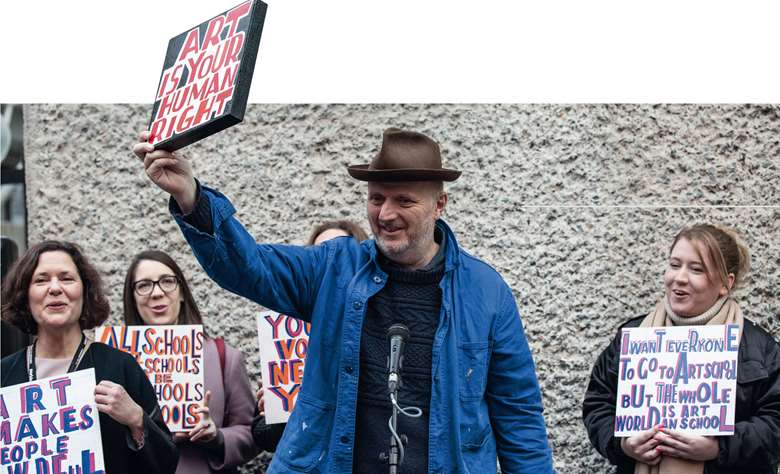Towards a Creative Curriculum
Eleanor Philpot
Saturday, February 1, 2020
A passionate call-to-arms, showing the arts to be an essential component in nurturing future generations

MARK SENIOR
Art is your human right!’ shouted several hundred arts teachers in unison as they responded to Bob and Roberta Smith's reading of his constitution for the arts, a detailed and extensive manifesto that is planning to encourage more arts across schools in the UK. And while this may not sound like the most typical opening for an education conference, it was how the Royal Shakespeare company, the Barbican and the Guildhall School of Music and Drama decided to kick things off at the Barbican for their joint-hosted conference ‘Towards a Creative Curriculum.’
This poignant speech – complete with hand painted signs which bore evocative and moving statements such as ‘Art makes people powerful’ – set the mood for the day. This was not going to be a sleepy conference, where the highlight would be free coffee and biscuits at eleven (although there were those) but one that called to really implement change in the lives of young people across the U.K, through the power of arts education.
Teachers and educators were at the heart of the conversations and debates taking place, ensuring that real stories and helpful tips took precedence over theoretical talk – which I'm sure many will agree can inspire in the moment but be of little help later down the line.
One of the most inspiring talks of the day came from the 2018 Global Prize Winner of Best Teacher in the World, Andria Zafirakou, who gave an incredibly touching keynote about how art can save and shape lives. Using images of her students’ work as a springboard she gave examples of former pupils who found themselves and their purpose through art. She relayed how a difficult student, struggling academically, found a new inner confidence thanks to his talent for drawing and painting.
There was also a young female student, whose final project featured dark and disturbing imagery that worried her teachers. In speaking to her about the piece, Zafirakou and her colleagues were able to get to the root of the issue. This young woman had been told that her dreams of becoming a doctor were not possible, because in a few months she would be married off to a stranger. In putting paintbrush to paper, she was able to express things she would never have had the power to say out loud.
This was one of the most powerful talks I have ever witnessed, and I found myself crying at the thought that so many teenagers in trouble will never be given that gift of self-expression.
The practical side of the conference was covered by a wide variety of workshops from arts institutions across the country, as well as the marketplace. Staged in the lobby, the marketplace exposed teachers to schools that have successfully implemented the arts into the day to day running of their institutions. Drama teachers would have been particularly inspired by the presentation by Treviglas Academy from Newquay in Cornwall who have focussed on producing school productions to an industry level through collaborating with theatres. While the team of teachers provided some helpful advice with regard to putting out ads or exchanging resources with local theatre groups, it did not take into account the difficulty that can come from starting from scratch and finding these contacts in the first place, since some schools can struggle to find support if they are based in a small town.
Perhaps it would have been more useful to have theatres, charities or hubs on hand to lend support and chat to schools from different areas, allowing practical steps to be made towards more thriving arts schools there and then.
While the marketplace wasn't as inspiring as the talks on offer, the workshops more than made up for this minor issue. One of the most inspiring sessions of the day was ‘Story-Led Resilient Practice’ led by Celine Wyatt and Phil Fairhurst from Blackpool Grand Theatre. By using the resilience framework based on Resilience Therapy, the pair showed how looking at key moments of resilience in shows can turn art into therapy, allowing students to work through and discuss important issues in their own lives. Teachers were even provided with hardcopy resources to take into the classroom the very next day and begin to implement change.

